Connecting with the Customer
 Print This Post
Print This Post
By Daniel Prial, NCAT Community Food Specialist
Being Authentic – Farmer First Marketing
Before I get into another blog post on farm marketing, I need to tell you that I am a dreamer. I was the high school kid who participated in mock government and wrote bills to solve all the county’s issues. I went into the Peace Corps. I’ve only ever held a job working with and for the public and nonprofit sectors. Somewhere, deep inside of me, hidden beneath veneers of humor and rational thinking, is an optimist.

Community Garden established by author and local group in Senegal, West Africa, showed the power of people coming together around a shared value. Photo: Daniel Prial
This is important because we’re going to talk today about making connection. If you are to understand where I’m coming from with this blog post, you need to understand who I am. I believe in the power of shared values. I have seen people come together to build a community garden out of nothing. I have watched as strangers join in song together. I know that shared values can make great things happen.
Which is why I recommend using your values as a foundation for your marketing plan. Bring to the world a bit of what is important to you. Grow the crops and raise the animals that you are passionate about and find customers who share that passion. This approach is referred to as the “Farmer-First” approach and, I believe, is the most authentic way for you to connect with your customer.
Traditional Marketing vs. Values-Based Marketing
Classic marketing theory suggests that you, as the producer of a product, should be answering the needs of your customer. As your customer lies in bed at night, worried about the future, your product should be the answer. Problem – Solution.
An example of this could be the young mother who is worried about the effects of organophosphates on the brain of her developing child. She desperately wants to purchase certified organic food. Your organic vegetables are a solution to her problem.

Road sign to far-off destinations at Ohio City Farm in Cleveland, Ohio, shows its value of working with refugees from around the world. Photo: Daniel Prial, NCAT
This theory forces you to respond to an already existing need. It is reactive thinking.
To counter this, Henry Ford supposedly said, “If I’d listened to what my customers wanted, I’d have given them a faster horse.” While this is, for sure, an oversimplification and almost certainly apocryphal, the idea is that you don’t have to be a follower in the marketplace. Use proactive thinking. Be a leader for your customers.
The ATTRA resource, Beyond Fresh: A Food Processing Guide for Texas Farmers, explores the idea of a “Farmer-First” approach to marketing:
Taking a Farmer-First approach means you are going to start with what YOU want, the products YOU can make—comfortably, easily, enjoyably, and consistent with your farming values. THEN you are going to ask if any of these products can be sold profitably, and to whom.
The Farmer-First perspective is basically about setting boundaries—as you have every right to do. Selling is not just about what the market wants but is more like a three-sided triangle. Your target market is driven by the products you decide to make. Your decision about what product to make is heavily influenced by the distribution channel you choose, as well as your farming values. And your choice of distribution channel depends on your target market. All these factors influence the others. You need to hold them all in your head at the same time and bring them into balance. If they won’t balance, you’re going to move on and think of something else to do. (Beckwith and Morris, 2019)
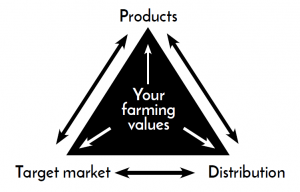
Farmer Focused Marketing
Couple this Farmer-First mentality with what we’ve talked about in previous blog posts Giving Your Products Meaning and Techniques for Selling the Farm Story. Your goal should be to create a set of values that have meaning to you and to your customer. For example, you value humanely raising animals and become Certified Humane. Your connected customer values animal welfare and shows that value by purchasing your product.
What we end up with is a positive coming together of values. Instead of a Problem – Solution mentality, it’s Values-Based Marketing.
I do not want to suggest that Values-Based Marketing is better than Problem – Solution marketing. In fact, it may make sense for a farm, for example, to market its CSA share as solving the problem of feeding a family and as the value of building community.

The hand-painted nature of the sign shows that Common Ground Farm in Washington, D.C., values people and simplicity. Photo: Daniel Prial, NCAT
In fact, Values-Based Marketing is still a discussion topic amongst marketing professionals. An Internet search shows a variety of articles with positive and negative arguments, as exemplified by an article in Marketing Dive some years back. However, when looking at the farm brand, you will likely have more success connecting to your customers and potential customers if you put your focus on Values-Based Marketing.
One Tool to Do This – The Marketing Avatar
To find your target audience, you’ll need to find the folks who have similar identities and values. One tool that can be useful for developing target audiences is called a Marketing Avatar. This avatar will represent a specific customer and serve as a focal point for your marketing thoughts.
Think about a specific person, or make up a specific person, who would want to buy from your farm. Maybe take a customer who has shopped with you since the day you opened for business. Write down everything you know about the person demographically, but really focus on this person’s goals and values. What is important to this person in life?
Now here’s the gold: where your farm values and your customer values overlap lies your marketing plan. You have grass-fed, humanely-raised dairy cows raised on a small farm just outside of town? Find the customer who values animal welfare and supporting local business. You’re a military veteran who grows hemp for CBD? Find the customer who values natural medicine and supporting the troops.
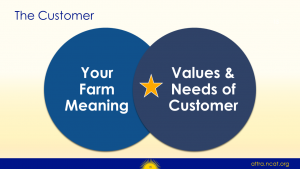
Slide from marketing presentation by author showing the overlap between farm values and customer values.
You don’t need to stop there. As you flesh out your avatar, consider the challenges this person faces. You don’t have to ignore classic marketing strategy. Also, try to understand where your customers get their information. This will help you refine your advertising. You know that all your customers also shop at a local coffee shop? Well, no need to take out a newspaper ad. Just put up a sign in the coffee shop.
For best results, complete this activity three or four times with different avatars. Try to expand your comfort zone with your avatar. You can imagine someone who uses SNAP benefits, who really wants high-quality food but cannot necessarily afford it. You can imagine the older person, set in his ways, who always buys his food from the big box store. Again, if it helps, start with a real customer of yours because you know you already have that market.
The values of each avatar might overlap with your farm values in different ways. One avatar might value the freshness than can only be found by buying direct and another avatar might value the nutrition of high-quality produce. Both of them overlap with the values of your small-scale vegetable operation.
Staying Authentic
Summed up, the work we did through the previous blog posts (Giving Your Products Meaning and Techniques for Selling the Farm Story) helped you build up ways to communicate your farm’s values. In this post, we reached out to customers with similar values. This method of marketing will let you enter the marketplace on your terms. It will let you lead with your most authentic self. And, hopefully, it’ll be easier than trying to bend your farm business into something that is uncomfortable for you, or doesn’t match who you are.
Related Resources:
This blog is produced by the National Center for Appropriate Technology through the ATTRA Sustainable Agriculture program, under a cooperative agreement with USDA Rural Development. ATTRA.NCAT.ORG.


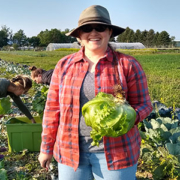
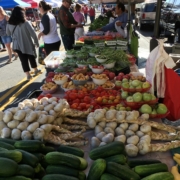


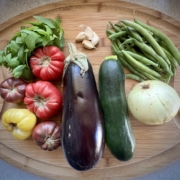
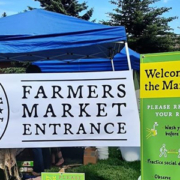

 USDA photo by Lance Cheung
USDA photo by Lance Cheung
